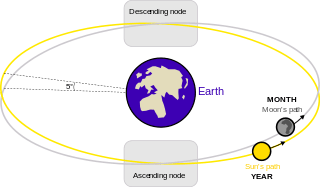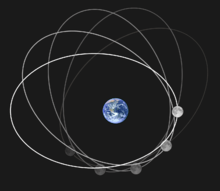Lunar precession
Precession is the change in direction of an axis of rotation with respect to a reference plane. The orbit of the Moon has two important such precessional motions.
Nodal precession

The first precession is movement of the plane of the lunar orbit. The period of the lunar nodal precession is defined as the time it takes the ascending node to move through 360 degrees relative to the vernal equinox. It is about 18.6 years and the direction of motion is westward, i.e. in the direction opposite to the Earth's orbit around the sun if seen from the celestial north. This is the reason that a draconic month or nodal period (the period of time that the Moon takes to return to the same node in its orbit) is shorter than the sidereal month. After one nodal precession period, the number of draconic months exceeds the number of sidereal months by exactly one. This period is about 6,793 days (18.60 years).
As a result of this nodal precession, the time for the Sun to return to the same lunar node, the eclipse year, is about 18.6377 days shorter than a sidereal year. The number of solar orbits (years) during one lunar nodal precession period equals the period of orbit (one year) divided by this difference, minus one. 365.25/18.6377 - 1

Apsidal precession
The second precession is that of the major axis of the Moon's elliptical orbit (the line of the apsides from perigee to apogee), which precesses eastward by 360 degrees in approximately 8.85 years. This is the reason that an anomalistic month (the period of time that the Moon moves from the perigee to the apogee and to the perigee again) is longer than the sidereal month (the period of time when the Moon completes one revolution with respect to the fixed stars). This apsidal precession completes one rotation in the same time as the number of sidereal months exceeds the number of anomalistic months by exactly one, after about 3233 days (8.85 years).
See also
Referenced
Explanatory Supplement to the Astronomical Almanac, P.K. Seidelmann (ed.), US Naval Observatory / University Science Books (1992): pp. 114,115; p. 701